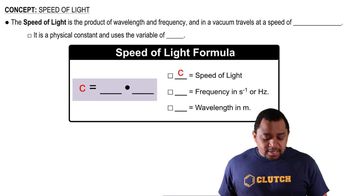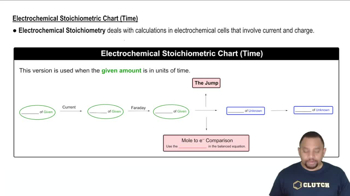Give the derived SI units for each of the following quantities in base SI units: (g) energy = mass × (velocity)2
Ch.1 - Introduction: Matter, Energy, and Measurement
Chapter 1, Problem 73c
The distance from Earth to the Moon is approximately 240,000 mi. (c) The speed of light is 3.00 ⨉ 108 m/s. How long does it take for light to travel from Earth to the Moon and back again?
 Verified step by step guidance
Verified step by step guidance1
Convert the distance from miles to meters using the conversion factor: 1 mile = 1609.34 meters.
Calculate the total distance for a round trip by multiplying the one-way distance by 2.
Use the formula for time: \( t = \frac{d}{v} \), where \( d \) is the total distance and \( v \) is the speed of light.
Substitute the total distance in meters and the speed of light \( 3.00 \times 10^8 \) m/s into the formula.
Solve for \( t \) to find the time it takes for light to travel to the Moon and back.

Verified video answer for a similar problem:
This video solution was recommended by our tutors as helpful for the problem above.
Video duration:
2mWas this helpful?
Key Concepts
Here are the essential concepts you must grasp in order to answer the question correctly.
Speed of Light
The speed of light in a vacuum is a fundamental constant of nature, approximately 3.00 × 10^8 meters per second. This speed is crucial for calculating how long it takes for light to travel a given distance, as it represents the maximum speed at which information or matter can travel in the universe.
Recommended video:
Guided course

Speed of Light Formula
Distance Measurement
In this context, the distance from Earth to the Moon is given as approximately 240,000 miles. To perform calculations involving the speed of light, it is essential to convert this distance into meters, as the speed of light is expressed in meters per second. Knowing the correct units is vital for accurate calculations.
Recommended video:
Guided course

Units of Radiation Measurement
Time Calculation
To determine the time it takes for light to travel a certain distance, the formula time = distance/speed is used. In this case, the total distance for a round trip to the Moon is twice the one-way distance. By applying this formula, one can find the time taken for light to make the journey to the Moon and back.
Recommended video:
Guided course

Electrochemical Stoichiometric Chart (Time)
Related Practice
Textbook Question
6
views
Textbook Question
The distance from Earth to the Moon is approximately 240,000 mi. (a) What is this distance in meters?
1
views
Textbook Question
The distance from Earth to the Moon is approximately 240,000 mi. (b) The peregrine falcon has been measured as traveling up to 350 km/ hr in a dive. If this falcon could fly to the Moon at this speed, how many seconds would it take?
1
views
Textbook Question
The distance from Earth to the Moon is approximately 240,000 mi. (d) Earth travels around the Sun at an average speed of 29.783 km/s. Convert this speed to miles per hour.
1
views
Textbook Question
Which of the following would you characterize as pure or nearly pure substance? (a) stomach acid; (b) dry ice; (c) ice-cream; (d) stainless steel; (e) petroleum; (f) distilled water; (g) carbon monoxide gas; (h) compressed air in balloon.
36
views
Textbook Question
The U.S. quarter has a mass of 5.67 g and is approximately 1.55 mm thick. (a) How many quarters would have to be stacked to reach 575 ft, the height of the Washington Monument?
1
views
